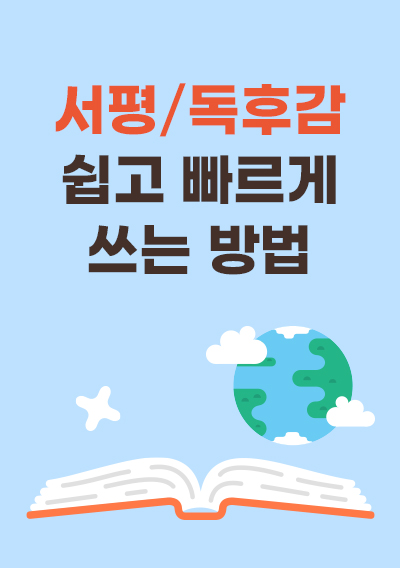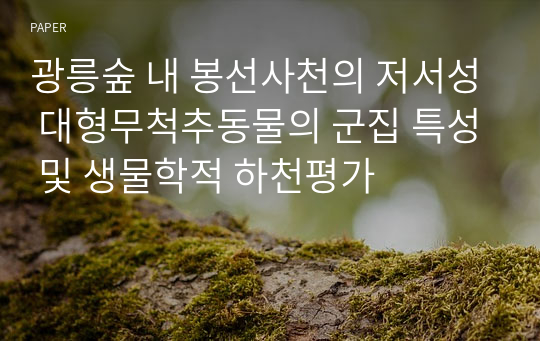광릉숲 내 봉선사천의 저서성 대형무척추동물의 군집 특성 및 생물학적 하천평가
* 본 문서는 배포용으로 복사 및 편집이 불가합니다.
서지정보
ㆍ발행기관 : 한국환경생태학회
ㆍ수록지정보 : 한국환경생태학회지 / 31권 / 6호
ㆍ저자명 : 정상우, 조용찬, 이황구
ㆍ저자명 : 정상우, 조용찬, 이황구
목차
서 론연구방법
1. 조사지점 및 시기
2. 조사방법 및 분석
결 과
1. 저서성 대형무척추동물상
2. 군집 특성 및 지표종 구성
3. 기능군 구성 및 종다양성
4. 하천평가 지수 분석
5. 수서곤충군집의 변화
고 찰
1. 저서성 대형무척추동물 군집 특성의 배경
2. 광릉숲 수생태계의 관리
REFERENCES
한국어 초록
광릉숲 생물권보전지역은 오랜 기간 보전 관리된 희귀 생태계로서 생물다양성 변화 모니터링 및 보전 연구가 활발하 게 수행되고 있다. 그러나 하천 건강성 평가 지표로서 저서성 대형무척추동물의 다양성과 군집 특성에 대한 연구는 찾아보기 어렵다. 본 연구는 2016년 4월부터 9월까지 광릉숲을 관통하는 봉선사천 및 인근 계류에 대한 하천평가를 위해 저서성 대형무척추동물의 군집분석을 수행하였다. 조사 결과, 저서성 대형무척추동물은 총 5문 8강 17목 56과 114종이 출현하였으며, 유수 지역에서 서식하는 하루살이목과 날도래목이 각각 30종(32.3%), 16종(17.2%)으로 다양성 이 높았고, 오염된 하천에서 일반적으로 정착하는 실지렁이류(Tubificidae sp.), 개똥하루살이(Baetis fuscatus), 명주각 다귀 KUa (Antocha KUa), 꼬마줄날도래(Cheumatopsyche brevilineata)의 출현빈도가 높게 나타났다. 섭식기능군에서 는 모아먹는무리와 잡아먹는무리가 비교적 높게 출현하였고, 계류지역에서는 썰어먹는무리와 긁어먹는무리가 높게 나타났다. 서식기능군에서는 붙는무리와 굴파는무리가 우세하게 출현하였으며, 여울지역의 미소서식처 다양성을 대변 하였다. 군집분석 결과, 우점도지수는 평균 0.48±0.10으로 분석되었으며, 광릉숲 계류의 GS 8에서 0.33으로 가장 낮게 나타났으며, 봉선사천 BS 1에서 가장 높게 나타났다. 다양도와 풍부도지수는 우점도지수와 반비례하여 나타났으 며, 우점도가 낮은 GS 8의 다양도와 풍부도지수는 각각 2.53, 4.22로 나타났다. 하천의 군집안정성 분석 결과, 봉선사천 은 저항력과 회복력이 높은 I특성군, 광릉숲 수계는 저항력과 회복력이 낮은 Ⅲ특성군이 높은 것으로 나타나 광릉숲의 수계가 교란에 민감한 종들이 많이 분포하고 있는 것으로 분석되었다. 생물학적 수질평가에서는 저서성 대형무척추동 물생태점수 50.88±17.69, 한국오수생물지수 1.11±0.57, 저서동물지수 78.55±11.05로 평가되었으며, 광릉숲 계류 GS 8에서 ESB (63점), KSI (0.55), BMI (89.9)로 가장 좋은 수환경과 수질 I등급인 최우선보호수역으로 나타났다. 그에 반에 봉선사천 BS 1에서는 ESB (25점), KSI (2.13), BMI (62.7)로 수질등급이 가장 낮은 III등급인 최우선개선수역으 로 평가되었다. 전체적으로 광릉숲 내의 수계보다는 주변에 위치한 봉선사천의 수계에서 수서곤충의 다양성은 증가하 는 것으로 나타났으나 과거 연도별 종구성의 군집구조는 뚜렷한 차이가 있는 것으로 나타났다.영어 초록
There have been many studies on monitoring of biodiversity changes and preservation of Gwangneung Forest Biosphere Reserve (GFBR) in South Korea in recognition of the rare ecosystem that has been preserved for a long period. However, there are few studies on diversity and community characteristics of benthic macroinvertebrates as an indicator of stream health of GFBR. The purpose of this study was to assess the water quality of Bongseonsa Stream that penetrated through Gwangneung Forest and the nearby torrents by analyzing the benthic macroinvertebrates community during April to September 2016. The investigation collected a total of 114 species of benthic macroinvertebrates belonging to 56 families, 17 orders, 8 classes, and 5 phyla from the Bongseonsa Stream and Kwangneung Stream. Ephemeroptera and Trichoptera were the largest groups in species diversity with 30 species (32.3%) and 16 species (17.2%), respectively, and Tubificidae sp., Baetis fuscatus, Antocha KUa, and Cheumatopsyche brevilineata, which usually habit in contaminated streams, appeared frequently. Among the feeding function groups, the gatherers and hunters appeared relatively frequently, and the shredders and scrapers appeared frequently in the torrents. Among the habitat oriented groups, the clingers and burrower appeared more frequently and represented the microhabitats in the shallow areas. The result of the analysis of benthic macroinvertebrates community showed that the dominant index was 0.48±0.10 in average while it was lowest with 0.33 in GS 8 of the Gwangneung Forest torrent and highest in BS 1 of Bongseonsa Stream. The diversity and richness indices were inversely proportional to the dominant index and were 2.53 and 4.22, respectively, in GS 8 where the dominant index was low. The result of the analysis of community stability showed that area I, which had high resistance and restoration, was high in Bongseonsa Stream while the area III, which had low resistance and restoration, was high in Gwangneung Forest, indicating that the water system in Gwangneung Forest had a wider distribution of specifies sensitive to agitation. The biological water quality assessment showed ESB of 50.88±17.69, KSI of 1.11±0.57, and BMI of 78.55±11.05. GS 8 of Gwangneung Forest torrent was judged to be the highest priority protective water area with the best water environment and I class water quality with ESB of 63, KSI of 0.55, and BMI of 89.9. On the contrary, BS 1 of Bongseonsa Stream was judged to be the high priority improvement area that had the lowest water quality rating of III with ESB of 25, KSI of 2.13, and BMI of 62.7. Although the diversity of water beetle was higher in the water system of nearby Bongseonsa Stream than the water system inside the Gwangneung Forest, the annual community structure appeared to have distinct differences.참고 자료
없음"한국환경생태학회지"의 다른 논문
 산림치유프로그램이 교사의 스트레스와 긍정・부정감정에 미치는 효과9페이지
산림치유프로그램이 교사의 스트레스와 긍정・부정감정에 미치는 효과9페이지 잠재 보호지역 발굴을 통한 국가 보호지역 확대 방안‐ 보호지역 부합성에 대한 전문가 인식을 중심으로..9페이지
잠재 보호지역 발굴을 통한 국가 보호지역 확대 방안‐ 보호지역 부합성에 대한 전문가 인식을 중심으로..9페이지 방과후 산림치유프로그램 활동이 유아의 친사회적 행동과 자아효능감 향상에 미치는 영향11페이지
방과후 산림치유프로그램 활동이 유아의 친사회적 행동과 자아효능감 향상에 미치는 영향11페이지 조릿대는 왜 평생 한 번 대규모로 꽃을 피우고 죽는가? ‐조릿대 개화지의 외적 환경인자 분석 및 그..14페이지
조릿대는 왜 평생 한 번 대규모로 꽃을 피우고 죽는가? ‐조릿대 개화지의 외적 환경인자 분석 및 그..14페이지 천연기념물 함안 대송리 늪지식물의 방문객 특성에 따른 활용 및 관리방안8페이지
천연기념물 함안 대송리 늪지식물의 방문객 특성에 따른 활용 및 관리방안8페이지 CO2 농도와 온도 변화가 기생 약초인 천마의 생육반응에 미치는 영향7페이지
CO2 농도와 온도 변화가 기생 약초인 천마의 생육반응에 미치는 영향7페이지 봉선사천의 참갈겨니(Zacco koreanus) 재도입 개체군과 원개체군 (조종천, 수동천) 간 생..12페이지
봉선사천의 참갈겨니(Zacco koreanus) 재도입 개체군과 원개체군 (조종천, 수동천) 간 생..12페이지 최근 10년(2006~2015년) 동안 한라산 구상나무림의 공간분포변화8페이지
최근 10년(2006~2015년) 동안 한라산 구상나무림의 공간분포변화8페이지 한국에 서식하는 아메리카동애등에 Hermetia illucens (Diptera: Stratiomy..9페이지
한국에 서식하는 아메리카동애등에 Hermetia illucens (Diptera: Stratiomy..9페이지 제주연안에서 기후변화가 갯녹음 확산에 미치는 영향8페이지
제주연안에서 기후변화가 갯녹음 확산에 미치는 영향8페이지


























